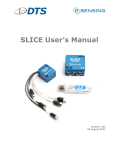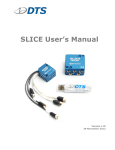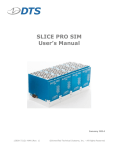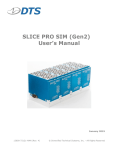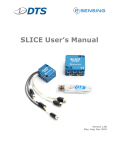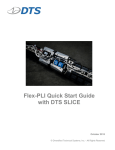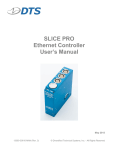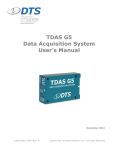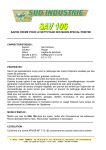Download Transient Shock Recorder(TSR) User`s Manual
Transcript
SLICE Free Motion Headform User’s Manual July 2012 13000-40180-MAN (Rev. 0) SLICE Free Motion Headform User’s Manual July 2012 Table of Contents DTS Support .................................................................................................... 4 Introducing the SLICE Free Motion Headform (FMH) System .......................... 5 Overview of SLICE FMH System ........................................................................5 13000-20010: SLICE NANO Base (1 each) .....................................................5 13000-20022: SLICE NANO Bridge (1 each) ...................................................5 13000-20090: SLICE FMH Stack Battery (1 each) ...........................................5 SLICE NANO Stack Cover (1 each) and Mounting Screws (2 each) .....................5 13000-30700: SLICE FMH LED Pushbutton Cable Assembly .............................6 13000-30680: Cable, FMH interface to SLICE system (1 each) .........................6 13000-30670: Cable, FMH interface to PC + power (1 each) ............................7 13000-30541: 12 V, 2.5 A power supply (90-240 VAC input) (1 each) ..............7 13000-30120: SLICE 1 Channel Sensor Connector Assembly (3 each) ...............7 13000-30131: SLICE 1 Channel Connector Cable Assembly (1 each) .................7 FMH Skull Cap Plate (1 each) ........................................................................7 Communications..............................................................................................8 Power/Charging Requirements ..........................................................................8 Status LED .....................................................................................................8 Basic Care and Handling ................................................................................. 9 Shock Rating ..................................................................................................9 Mounting Considerations ............................................................................. 10 Thermal Considerations .................................................................................. 10 SLICEWare Software ..................................................................................... 10 Software Installation ...................................................................................... 10 Communicating with the SLICE FMH System ..................................................... 10 How to Auto-Arm the SLICE FMH System ......................................................... 11 Troubleshooting ......................................................................................... 12 Downloading Data ......................................................................................... 12 Viewing Data ................................................................................................ 13 Exporting Data .............................................................................................. 14 Real Time Mode ............................................................................................ 15 Appendix A: SLICE Hardware Specifications................................................. 16 Appendix B: Pin Assignments ....................................................................... 17 13000-30131 Termination Specifications .......................................................... 17 [email protected] ii 13000-40180-MAN (Rev. 0) SLICE Free Motion Headform User’s Manual July 2012 10-pin Interface Connector ............................................................................. 17 5-socket FMH Interface Connector ................................................................ 18 12-socket FMH Interface Connector ................................................................ 18 Appendix C: SLICE FMH Assembly Procedure ............................................... 19 Appendix D: Minimizing System Self-Heating ............................................... 26 [email protected] iii 13000-40180-MAN (Rev. 0) SLICE Free Motion Headform User’s Manual July 2012 DTS Support SLICE data acquisition systems are designed to be reliable and simple to operate. Should you need assistance, DTS has support engineers worldwide with extensive product knowledge and test experience to help via telephone, e-mail or on-site visits. The best way to contact a DTS support engineer is to e-mail [email protected]. Your e-mail is immediately forwarded to all DTS support engineers worldwide and is typically the fastest way to get a response, particularly if you need assistance outside of normal business hours. For assistance by telephone, please go to http://dtsweb.com/support/techsupport.php to find the phone number appropriate for your region of the world. [email protected] 4 13000-40180-MAN (Rev. 0) SLICE Free Motion Headform User’s Manual July 2012 Introducing the SLICE Free Motion Headform (FMH) System The SLICE FMH system is a miniature data acquisition system (DAS) designed for integration into a dummy head. It includes a battery sufficient to run the system for up to 20 minutes and supports autonomous operation after arming. After the test, reconnecting the system to a PC and the provided power supply allows data download, viewing and post-processing, and recharges the battery for the next use. Overview of SLICE FMH System A typical 3-channel system is discussed below. additional channels or custom features. Your system may vary if you have Detailed assembly procedures can be found in Appendix C: Procedure. SLICE FMH Assembly Figure 1: 3-channel SLICE NANO Stack for FMH 13000-20010: SLICE NANO Base (1 each) 13000-20022: SLICE NANO Bridge (1 each) 13000-20090: SLICE FMH Stack Battery (1 each) SLICE NANO Stack Cover (1 each) and Mounting Screws (2 each) Figure 1 shows a typical 3-channel, SLICE FMH Stack that includes a Base SLICE, Bridge SLICE, SLICE FMH Stack Battery, stack cover plate, and two M3 x 35 mm or 4-40 x 1-3/8" mounting screws. Detailed specifications for the Base SLICE and Bridge SLICE can be found on page 16 (Appendix A: SLICE Hardware Specifications) or at www.dtsweb.com . Details on the SLICE FMH Stack Battery can be found on page 8 (Power/Charging Requirements). For information on operation of the SLICE system, please see the SLICE User’s Manual. [email protected] 5 13000-40180-MAN (Rev. 0) SLICE Free Motion Headform User’s Manual July 2012 The 12-socket connectors are functionally identical. Figure 2: FMH Interface 13000-30700: SLICE FMH LED Pushbutton Cable Assembly This cable (Figure 3) is used inside the dummy head and connects to the 5-socket connector shown in Figure 2 and the FMH skull. The pushbutton enables the auto-arm sequence and the LED provides information on arming status. Additional information on the LED can be found on page 8 (Status LED); details on arming the system begin on page 11 (How to Auto-Arm the SLICE FMH System). Figure 3: 13000-30700 Cable Assembly 13000-30680: Cable, FMH interface to SLICE system (1 each) This cable is used inside the FMH skull (Figure 4) and connects to either 12-socket connector shown in Figure 2. It terminates at the inside of the skull cap plate and mates with 13000-30670. Figure 4: 13000-30680 Cable Assembly [email protected] 6 13000-40180-MAN (Rev. 0) SLICE Free Motion Headform User’s Manual July 2012 13000-30670: Cable, FMH interface to PC + power (1 each) This cable (Figure 5) connects to the USB port on your PC and the power supply provided with your system. It mates with 13000-30680 as it exits the skull cap plate. Figure 5: 13000-30670 Cable and Interface 13000-30541: 12 V, 2.5 A power supply (90-240 VAC input) (1 each) A 12 V, 2.5 A power supply (Figure 6) is provided with your system. It will simultaneously charge the battery and power the SLICE FMH system until it is disconnected prior to the test. Battery capacity and charging requirements can be found on page 8 (Power/Charging Requirements). Figure 6: 13000-30541 Power Supply 13000-30120: SLICE 1 Channel Sensor Connector Assembly (3 each) Three, 7-pin, sensor connectors with back shell and ID are provided for use with your sensors. If not included separately, these are already installed on your sensors. 13000-30131: SLICE 1 Channel Connector Cable Assembly (1 each) This 7-socket, 50 cm cable assembly is provided to facilitate sensor calibration. It is provided without terminations to allow the user the option of attaching a connector of their choice. Sensors can then be disconnected individually from the Bridge SLICE and calibrated with the use of this cable. A termination drawing can be found on page 17 (13000-30131 Termination Specifications). FMH Skull Cap Plate (1 each) This was provided with your Free Motion Headform. You may be provided a new plate that has been modified to accept cable 13000-30680 (FMH interface to SLICE system) and to compensate for the added mass of the SLICE FMH system, or your plate may [email protected] 7 13000-40180-MAN (Rev. 0) SLICE Free Motion Headform User’s Manual July 2012 need to be modified. Please contact your SLICE FMH system integrator or FMH vendor for additional information. Communications A USB-to-PC communication and power cable (DTS P/N 13000-30670) is provided with your system. All communication signals and power/battery charging are supported via the LEMO interface (Figure 4). Information on installing the software, initializing the system, downloading and viewing the data begins on page 10 (SLICEWare Software). Power/Charging Requirements The SLICE FMH Stack Battery contains an integrated, 8.4 V, 80 mAh, rechargeable lithium battery sufficient to operate the system for cable-free testing. When the 12 V, 2.5 A power supply is connected to your system, it will simultaneously charge the battery and power the SLICE FMH system until it is disconnected prior to the test. Battery life (fully charged) Up to 20 minutes (full sensor load) Charge time ~1 hour from complete discharge to full charge; always charges when connected to power supply Charging the system using a maximum of 12 V and without the USB connected minimizes system self-heating. Additional details can be found in Appendix D. Status LED This LED is blue and provides information on arming and recording status. It is on, off or blinking. After unit is turned on, LED will blink during sensor warm-up and system arming. Blinking ON OFF If armed in Circular Buffer mode, the LED will begin recording after sensor warmup and the LED will go solid blue. The LED will also go solid blue in Recorder mode if the system received a START signal. If armed in Recorder Mode, the system will stop blinking and go OFF, waiting for a START signal to begin recording. [email protected] 8 13000-40180-MAN (Rev. 0) SLICE Free Motion Headform User’s Manual Circular Buffer Mode July 2012 Recorder Mode (rate increases) Arming; sensor warm-up (~30 sec) (LED is ON) (LED is OFF) System is recording Waiting for START signal (rate steady) If the LED continues to blink after 45 sec, the system did not initialize properly. See page 12 (Troubleshooting). To arm the system, press and hold the LED pushbutton switch for >3 sec. After 7 sec, the LED will begin to blink, indicating the system is performing the auto-arm initialization sequence. After 32 sec, the LED will be either on (circular buffer mode) or off (recorder mode). Note: The SLICE FMH system’s auto-arm feature must be softwareenabled prior to pushbutton initialization. Only Circular Buffer mode is recommended for use with the FMH. Details on software installation and use begin on page 10 (SLICEWare Software). Basic Care and Handling The SLICE FMH system is a high precision measurement instrument, designed to operate reliably in dynamic testing environments. Though resistant to many environmental conditions, care should be taken not to subject the unit to harsh chemicals, submerge it in water, or use it in a manner inconsistent with its intended purpose. The Base SLICE, Bridge SLICE and SLICE FMH Stack Battery are supplied with calibration data from the factory. DTS recommends annual recalibration to ensure that the system is performing within factory specifications. SLICE hardware is not userserviceable and should be returned to DTS for service or repair. Shock Rating The SLICE FMH system is rated for 500 g, 4 ms duration, in all axes. All mounting considerations should be thoroughly addressed to ensure the system is adequately integrated to survive the expected shock loads. [email protected] 9 13000-40180-MAN (Rev. 0) SLICE Free Motion Headform User’s Manual July 2012 Mounting Considerations To provide the best shock protection, the system should be securely bolted inside the FMH skull using the proper hardware and recommended torque specifications. Care must be taken to restrain the cables to permit adequate strain relief and minimal movement upon impact. Thermal Considerations The SLICE DAS is an extremely low power system with negligible self-heating. Should any self-heating be a concern, this can be addressed by charging the system properly and minimizing the time it takes to arm the system and perform the test (see Appendix D). Should you have any questions about using SLICE in your environment, please contact DTS. SLICEWare Software Software Installation 1. Locate the set-up.exe file on the CD or USB drive provided. Double-click the file to begin the installation and follow the prompts on your screen. 2. When installation is complete, copy the XML file found in the folder “copy contents to SLICEWare directory after software install ” to the SLICEWare directory. (The XML file contains the sensor information.) If you were not provided an XML file, you will have to enter this information later. 3. Start SLICEWare by double-clicking the desktop icon or go to Programs/ SLICEWare. If you have any [email protected]. questions about software installation, please contact Communicating with the SLICE FMH System 4. Connect cable 13000-30670 to the LEMO receptacle on the skull cap plate (Figure 5). Next, connect the cable to the power supply provided (Figure 6) and your PC. (The SLICE FHM system can be connected to the PC before or after starting the software.) 5. If you provided your own sensors or had to replace a sensor, you can manually enter the sensor information into the SLICEWare software before using your SLICE FMH system. (Check that the sensors that are installed in the FMH are visible on the tab. If any sensor is missing, you need to manually install it.) You will need the calibration data provided with your sensors to do this. Each sensor must also be assigned to the correct axis and optional ISO code. [email protected] 10 13000-40180-MAN (Rev. 0) SLICE Free Motion Headform User’s Manual July 2012 How to Auto-Arm the SLICE FMH System The “Auto-Arm on Boot” feature allows users to automatically arm the system using user-selected parameters at system power-up/initialization. To use the auto-arm feature, all DAS in the test must support the auto-arm function. 6. With SLICEWare running and the SLICE FMH system connected (step 4 above), go to the working properly. [email protected] tab and perform a quick check to verify the hardware is 11 13000-40180-MAN (Rev. 0) SLICE Free Motion Headform User’s Manual July 2012 7. Open the tab. Complete the test set-up information (data collection mode, length of time, sample rate, etc.). 8. Click the Auto-Arm button. Click OK. 9. Close SLICEWare and disconnect cable 13000-30670 from the skull cap plate. 10. To arm the system, press and hold the LED/pushbutton switch for >3 sec. After 7 sec, the LED will begin to blink, indicating the system is performing the auto-arm initialization sequence. After 32 sec, the LED will be either on (circular buffer mode) or off (recorder mode). Troubleshooting If the LED continues to blink after 45 sec, the system did not initialize properly. To clear the fault, reconnect the system to the power supply and PC (step 4 above), then start SLICEWare. Manually arm and test the SLICE FMH system to clear the fault. (You must clear the fault before the system will power down.) After clearing the fault, repeat steps 7-10 above. Downloading Data 1. Reconnect the system to the power supply and PC (step 4 above). SLICEWare. 2. Open the set-up, select Start tab. To download the total time specified by the initial test . To download a region-of-interest only, enter the desired timeframe (for example, ) and then select . 3. Depending on the length of the test, it may take several minutes or longer to download the data. A download progress bar is shown in the center of the screen alongside the corresponding DAS. [email protected] 12 13000-40180-MAN (Rev. 0) SLICE Free Motion Headform User’s Manual July 2012 Viewing Data 1. Open the tab. Available data sets for viewing are shown on the left. These data sets are stored on your PC, not the SLICE. 2. Selecting a test will load it in the viewing area. 3. You can zoom using the can also zoom by selecting of-interest. [email protected] and icons on the upper right of the screen. You and then drawing a window around a region- 13 13000-40180-MAN (Rev. 0) SLICE Free Motion Headform User’s Manual July 2012 4. Multiple data channels can be viewed on the graph at one time. You can choose which channels to view using . 5. The data can be viewed unfiltered or using a selected filter. Exporting Data 1. Open the available. [email protected] tab and select the data set you wish to export from the tests 14 13000-40180-MAN (Rev. 0) SLICE Free Motion Headform User’s Manual July 2012 2. Select an export format for the data. 3. Select whether or not you want the exported data to be filtered or unfiltered. If filtered is selected, SLICEWare will apply the software filter associated with each sensor in the test. 4. To export the data using the settings you selected above, select . A ‘save as’ dialog will open and allow you to choose where to save the exported data. Real Time Mode To view data from the channels real time, click the tab. You can view any or all of the three channels. Note that the data is being sampled continuously at a relatively low sample rate. For example, you may not see a short duration data pulse when hitting the SLICE against a surface. [email protected] 15 13000-40180-MAN (Rev. 0) Specifications BASE SLICE (MICRO & NANO) Size: Weight: Connectors: Connectors: ENVIRONMENTAL Operating Temp.: SERVICES 24/7 Worldwide Tech Support ISO 17025 (A2LA) Calibration Onsite Calibration & Training Application Consulting Software Integration OEM/Embedded Applications Humidity: Shock: DATA RECORDING Modes: Memory: Sample Rate: TRIGGERING Hardware Trigger: Level Trigger: MICRO 42 x 42 x 8 mm (1.65 x 1.65 x 0.32”) NANO 26 x 31 x 6.5 mm (1.02 x 1.22 x 0.26”) MICRO ~28 g (0.99 oz), NANO ~14.2 g (0.50 oz) Omnetics, circular locking, 12-pin MICRO integrated, NANO cable assembly 0 to 60°C (32 to 140°F) Call to discuss extended temperature ranges 95% RH non-condensing 500 g, 4 msec half sine 5000 g option (SLICE NANO) 50,000 g option (SLICE HG) Recorder or circular buffer modes available. 7 GB non-volatile flash per SLICE stack Up to 120 ksps/channel Individual channel sample rate is determined by number of SLICEs in each stack Isolated contact closure & logic-level input Software programmable from any channel(s) Power Control: Protection: SOFTWARE Control: Operating Systems: Communication: 9-15 VDC; >11 VDC when using BATT SLICE 100 mA. Each additional SLICE unit requires additional power (depends significantly on connected sensor load) Remote power control input for on/off Reverse current, ESD SLICEWare, API Windows® XP/Vista/7 USB; optional Ethernet interface BRIDGE SLICE (MICRO & NANO) Size: Weight: Connectors: MICRO 42 x 42 x 7 mm (1.65 x 1.65 x 0.32”) NANO 26 x 31 x 5.5 mm (1.02 x 1.22 x 0.22”) MICRO ~25 g (0.88 oz), NANO ~13.8 g (0.49 oz) Omnetics, circular locking; 3 single-channel 7-pin or 1 three-channel 16-pin SIGNAL CONDITIONING Number of Channels: Input Range: Bandwidth: Gain Range: Auto Offset Range: Bridge Support: Shunt Check: 3 differential, programmable ±2.4 V (2.5 V center) DC to 40 kHz, programmable 1.0-1280, programmable 100% of effective input range Software switchable completion Emulation method ANALOG-TO-DIGITAL CONVERSION Type: EXCITATION Method: Voltage: On/Off Control: TECH CENTERS Seal Beach, California USA Novi, Michigan USA Sydney, Australia Shanghai, China Zorge, Germany Tokyo, Japan POWER Voltage: Current (Maximum): ANTI-ALIAS FILTER Fixed Low Pass: Size: Weight: Connectors: MICRO 42 x 42 x 7 mm (1.65 x 1.65 x 0.28”) ~28 g (0.99 oz) 10-32 coaxial (Microdot-compatible) SIGNAL CONDITIONING Number of Channels: Input Range: Bandwidth: Gain Options: Auto Offset Range: 3 0.5-23.5 V (12 V center) DC to 40 kHz, programmable 1 or 10, user programmable 100% of effective input range at gain of 1 ANALOG-TO-DIGITAL CONVERSION Type: EXCITATION Method: Voltage: On/Off Control: POWER Voltage: Current (Maximum): 16-bit SAR, one ADC per channel One 2.2 mA constant-current source/channel up to 24 V Shut down when not armed or recording Supplied via BASE SLICE 70 mA with sensors connected to all channels ANTI-ALIAS FILTER Fixed Low Pass: POWER Supply Voltage: Current (Maximum): IEPE SLICE (MICRO Only) 16-bit SAR, one ADC per channel 4-pole Butterworth, standard knee frequency of 40 kHz Adjustable Low Pass: 5-pole Butterworth set under software control, 50 Hz to 40 kHz Overall Response: Both filters may be used together to achieve 9-pole effective response ARS SLICE (MICRO Only) Size: Weight: Number of Channels: Range Options: Current (Maximum): ACCEL SLICE (MICRO Only) Size: Weight: Number of Channels: Range Options: Current (Maximum): MICRO 42 x 42 x 9 mm (1.65 x 1.65 x 0.35”) ~30 g (1.06 oz) 3 Triaxial, ±50, 100, 500 g 65 mA (power supplied via BASE SLICE) BATTERY SLICE (NANO Only) Size: Weight: Charge Status: Charge Time: One 20 mA current-limited source/channel 5.0 V Shut down when not armed or recording Opt. pulsed excitation for low sampling rates MICRO 42 x 42 x 9 mm (1.65 x 1.65 x 0.35”) ~30 g (1.06 oz) 3 Triaxial, ±300, 1500, 8k, 12k, 50k deg/sec 75 mA (power supplied via BASE SLICE) Discharge Rate: NANO 26 x 31 x 4 mm (1.65 x 1.65 x 0.16”) ~7 g (0.25 oz) Backup battery charges when input voltage to BASE SLICE is greater than 11 VDC ~15 min. from complete discharge to full charge (100 mA at input connector on Base) ~16 seconds at 1 A ~2 minutes at 400 mA Supplied via BASE SLICE 110 mA with 350 ohm bridges all channels Power will vary significantly with sensor load 4-pole Butterworth, standard knee frequency of 40 kHz Adjustable Low Pass: 5-pole Butterworth set under software control, 50 Hz to 40 kHz Overall Response: Both filters may be used together to achieve 9-pole effective response SAE J211: System exceeds SAE J211 response Diversified Technical Systems, Inc. Electric Ave., Suite 206 Seal Beach, CA 90740 USA Phone: +1 562 493 0158 Email: [email protected] www.dtsweb.com Specifications subject to change without notice. SLICE Free Motion Headform User’s Manual July 2012 Appendix B: Pin Assignments 13000-30131 Termination Specifications 1 2 5 3 6 7 (looking into the connector) Pin Wire color Function 1 Green +Sig 2 White -Sig 3 Red +Ex 4 Yellow +ID 5 Black -Ex 6 Shield -ID/Shield Notes Solder bridge on pins 6 and 7 10-pin Interface Connector (ECG.1B.310.CLL) 1 8 2 7 9 10 3 4 6 5 (panel view) Pin Function Pin Function 1 /ON 6 Ground 2 /START 7 USB power 3 /EVENT 8 USB_DP 4 Status 9 USB_DM 5 12-15 VDC [email protected] 10 17 USB Ground 13000-40180-MAN (Rev. 0) SLICE Free Motion Headform User’s Manual July 2012 5-socket FMH Interface Connector 12-socket FMH Interface Connector* 1 5 4 8 3 2 1 3 (looking into the connector) Pin 4 Function 7 10 11 12 (looking into the connector) Pin Function 1 −Status 1 On (contact closure input to ground) 2 Ground 2 Start (contact closure input to ground) 3 +Status 3 Event (contact closure input to ground) 4 On 4 Status output (5 V via 10K with respect to ground) 5 Event 5 12–15 VDC 6 12–15 VDC 7 Ground 8 Ground 9 USB_PWR 10 USB_DP 11 USB_DM 12 Ground * These connectors are identical. [email protected] 18 13000-40180-MAN (Rev. 0) SLICE Free Motion Headform User’s Manual July 2012 Appendix C: SLICE FMH Assembly Procedure 1. Mount the SLICE system and sensors to the neck load cell structural replacement using the proper hardware and recommended torque specifications by the FMH manufacturer. Carefully route all cables and use tie downs to create adequate strain relief and minimize cable movement. All mounting considerations should be thoroughly addressed to ensure the system is adequately integrated to survive the expected shock loads. FMH Interface The 12-socket connectors are functionally identical and either may be used to connect the Base SLICE “UP” connector or cable 13000-30680 (FMH interface to SLICE system). [email protected] 19 13000-40180-MAN (Rev. 0) SLICE Free Motion Headform User’s Manual July 2012 2. Attach cable 13000-30680 (FMH interface to SLICE system) to skull cap plate using the provided hardware. Tighten securely. [email protected] 20 13000-40180-MAN (Rev. 0) SLICE Free Motion Headform User’s Manual July 2012 3. Attach cable 13000-30700 (SLICE FMH LED Pushbutton Cable Assembly) by threading it into the FMH skull. Tighten securely. [email protected] 21 13000-40180-MAN (Rev. 0) SLICE Free Motion Headform User’s Manual July 2012 4. Insert neck load cell structural replacement into skull. Note the position of the flat edge relative to the FMH skull. 5. Rotate neck load cell structural replacement counter-clockwise so that the FMH interface is visible. Connect cable 13000-30700 (SLICE FMH LED Pushbutton Cable Assembly) to the FMH interface. [email protected] 22 13000-40180-MAN (Rev. 0) SLICE Free Motion Headform User’s Manual July 2012 6. Connect cable 13000-30680 (FMH interface to SLICE system) to the FMH interface using the available 12-socket connector. [email protected] 23 13000-40180-MAN (Rev. 0) SLICE Free Motion Headform User’s Manual July 2012 7. Rotate neck load cell structural replacement clockwise so that the flat edge of the neck load cell structural replacement is aligned properly. Secure it to the aluminum skull using the proper hardware and recommended torque specifications by the FMH manufacturer. [email protected] 24 13000-40180-MAN (Rev. 0) SLICE Free Motion Headform User’s Manual July 2012 8. Route the cable into the skull and install the skull cap plate using the proper hardware and recommended torque specifications by the FMH manufacturer. [email protected] 25 13000-40180-MAN (Rev. 0) SLICE Free Motion Headform User’s Manual July 2012 Appendix D: Minimizing System Self-Heating Following the procedure outlined below will avoid any unnecessary heat generation in excess of ~1°C. 1. Charge the system using a 12 V power supply. 12 V is the minimum required by the SLICE system; anything in excess will contribute to heat generation. 2. Do not connect your PC to the system while it is charging. While this prevents checking system status, continual PC communications keep the microprocessor active. If the battery is not completely discharged and you do not want to wait the maximum recharge time (1 hour), you may wish to implement a hardware interface that allows you to check battery charge status. When the input current drops to 75 mA, the battery is fully charged. 3. Complete the software auto-arm sequence and disconnect the system from the PC and power supply within 2 minutes. Completing this step quickly minimizes system and sensor self-heating. Once auto-arm and disconnect are completed, the system is in a low-power state and awaiting initialization. 4. Initialize the system and perform your test quickly. To initialize the system, press the LED/pushbutton switch for ≥3 sec. When the LED goes solid, the system is ready for testing. Performing your test as soon as possible after system initialization minimizes self-heating. [email protected] 26 13000-40180-MAN (Rev. 0) SLICE Free Motion Headform User’s Manual July 2012 Revision History Date By 13 Jul 2012 EKK [email protected] Description Initial release. (Rev 0) 27 13000-40180-MAN (Rev. 0)



























